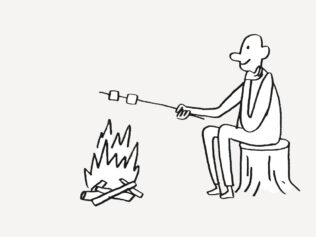
How can we fall asleep quickly, sleep well, and wake up rested? Adam Wichniak, a psychiatrist from the Sleep Disorders Centre at the Institute of Psychiatry and Neurology in Warsaw, talks to Aleksandra Pezda about how to cope with sleep problems.
Aleksandra Pezda: It’s late at night. I’ve already watched the eighth season of Homeland, scrolled through my Instagram and Facebook newsfeed, and I still can’t fall asleep.
Adam Wichniak: None of these behaviours helps you fall asleep. On the contrary, each makes it even more difficult, exacerbating your sleep problems. If you’re already in bed, but decide to check email on your smartphone or watch TV, you aren’t ready to sleep. But we will discuss this later.
You might find some consolation in the fact that you are not alone. Every second Polish adult experiences some sleep problems for at least a few weeks throughout the year, whereas every fourth feels the effect of insufficient sleep during the day. There are various types of sleep disturbances, though. One might have difficulty falling asleep, wake up in the middle of the night, or wake up too early and struggle to get back to sleep. Each problem has its own consequences such as irritability, lowered cognitive performance or focus; to put it simply, thinking problems. This can happen even after one sleepless night. After a few months of not getting enough sleep, the complications might become more serious and include high blood pressure, cardiac arrhythmia, menstrual disorder, or the loss of libido. If any of these problems are observed, you should seek medical help.
What does it mean to have insomnia?
Insomnia – understood as a mental disorder – can be diagnosed only when a person experiences the above symptoms both at night and during the day for a prolonged time, which is now thought to be over three months. However, insomnia is rarely an isolated illness. In most cases, sleep disturbances result from an unhealthy lifestyle or accompany other health conditions such as anxiety disorder, depression, chronic pain or hypertension. Traditionally, in medicine we would diagnose and treat only the cause of the disease, ignoring patients’ lifestyle. For example, we would diagnose and treat pain, forgetting that unless patients change their everyday habits, their sleep problems won’t go away. A patient who hasn’t been sleeping well for three days due to a common cold, might again sleep like a baby once their nasal congestion is cleared up. But what if a patient goes through a major life crisis – like a divorce or the death of a child – and this is why they haven’t been sleeping for months? They shouldn’t delude themselves into thinking that their insomnia will simply go away while they are still dealing with trauma. Moreover, their sleep pattern must be so erratic that it would require separate treatment.
For that reason, American psychiatrists suggested we should no longer differentiate between primary insomnia – classified as an isolated medical condition – and secondary insomnia, which is directly linked to other diseases or unhealthy lifestyle. Patients need to get help regardless of the type of insomnia they have, and this is what modern treatment is about.
According to the World Health Organization, every third adult doesn’t get enough sleep. Research shows that we should get between seven and nine hours of sleep each night. Six hours isn’t enough?
Yes, it isn’t enough if we mean a six-hour sleep pattern. We tend to neglect sleep from adolescence onwards. This is what our nights look like nowadays: we’re watching TV, using social media, partying, studying or working. We imagine, however, that this kind of lifestyle won’t impact our health. What makes the situation even worse is how we use the new media. Instead of focusing on one TV programme, we switch between channels or binge-watch. Before we finish reading one article, we click on another, and then another one. We scan our Facebook newsfeed only to switch to Instagram and Twitter, and then go back to Facebook again. Then we decide to check our email, and so on. We’re constantly using different media platforms, simply because there is such an opportunity – they’re accessible 24/7. Do you think that our organism isn’t affected by that?
From a medical perspective, how does watching one movie differ from switching between a few?
The difference is huge. Not only our fingers – which operate the remote or scroll the screen –are working then. It is primarily our brain that has to work: it scans, reads and makes decisions. Do you know anybody who goes online to search for content they don’t care about? I don’t. We’re exposed to information that is either pleasant or distressing. Among 10 new messages in our mailbox, there might be some from our employer, and they’re likely to make us feel tense. We also find worrisome information in the news: a hurricane, an accident,
a politician who disappoints us. And what do we get on Instagram? Pictures of our friend vacationing in a nicer spot than we are, and our colleague who is a better runner. Each time, this kind of news causes cognitive arousal and emotional outburst. So if you use your smartphone all day long, take it to bed, and again scroll through the newsfeed, then it’s your fault that you can’t fall asleep. You simply don’t let your brain rest.
Our brain is being constantly stimulated. In effect, it produces hormones and activates our sympathetic nervous system. This leads, for instance, to increased levels of cortisol: a stress hormone. It should be remembered that regardless of whether we’re watching a movie that realistically depicts a tiger’s attack or we’re experiencing it in real life, our organism responds in a similar way. What might differ is the level of agitation. Now, let’s add up those behaviours that together cause your sleep problems How much time have you spent on your phone today?
My smartphone says that I use it for two and a half hours a day.
Please add TV viewing time.
I rarely turn on the TV.
This is a typical response. My patients also say they don’t watch TV. But what about films on Netflix or HBO? If we add that to the time we spend on our smartphones and computers, the numbers are alarming. We tend to use phones during a break at work, even if we work on a computer. We scroll the screen on the metro, in the shopping queue or at the doctor’s. That’s what we do instead of reading a book or having a conversation. Teenagers spend over four hours a day on their phones; some of them even more than half a day.
There is something about it. British paediatricians found out that even kids under the age of five have sleep problems because they spend too much time in front of a smartphone screen. But instead of cognitive exhaustion or emotions, they discussed the blue light that smartphones emit.
This is yet another problem, which is related to a biological mechanism: how the human organism adapts to the circadian rhythm. Sleep is one of the most important biological rhythms, like appetite, muscle strength and intellectual abilities. In fact, each body cell works according to its own biological clock, which is regulated by genes. This means there are particular times of the day when our kidneys, muscles or liver work most effectively, and there are times suitable for sleep or rest. All clocks work together and their synchronization influences our mood and health. Our main biological clock that controls those mechanisms is called the suprachiasmatic nucleus – it is a tiny part of our brain located in the hypothalamus. The hormones that it produces are responsible for how the bodily processes are aligned with the outside environment – for instance, the changing of seasons, and the day and night cycle. Evolution regulated it well. Our organism, without our conscious control, can by itself adapt to the circadian rhythm. It helps us function in optimal conditions – work during the day and rest at night, when it would be less safe to be active. And everything was working well for ages…
…till Edison presented the lightbulb.
The bulb itself wasn’t so harmful as long as it emitted warm yellow light, like that from a bonfire, lighted torch or kerosene lamp. This type of light doesn’t affect us badly. When the light is soft and red, it can even be relaxing and help us fall asleep. The problem started when fluorescent lamps, which emit lots of blue light, were introduced. Thankfully, their light is rather unpleasant, so we mostly switch them on during the day to make a dark room brighter, especially at the workplace. I had such a lamp in my office, too. Rarely, however, would we install fluorescent lamps in our bedrooms, so they didn’t cause sleep disturbances on a mass scale. It wasn’t until modern fluorescent lamps and LED bulbs became widely used that the centuries-old work of evolution was wasted. Daylight, which would normally help us to sleep, is now one of the most common reasons behind sleep disorders. In addition, energy-efficient modern devices no longer have incandescent screens with yellow light, but LED ones, which emit blue light. Smartphone screens, now widely in use, trick our brain and cause chaos inside our body.
What is wrong with blue light?
Nothing, unless we are overexposed to it. Blue light imitates daylight, and thus stimulates us. This is how it works: the retina of the human eye is made up of ganglion cells, which align the human organism with the outside environment. These cells aren’t responsible for our vision, which is why some blind people adapt well to the circadian rhythm. Ganglion cells contain melanopsin – a photo pigment, which sends a message to the hypothalamus as to whether it is day or night. The hypothalamus, in turn, releases hormones that trigger the pituitary gland, which regulates the activity of the autonomous nervous system. As a result, the organism either wakes up or rests.
Natural blue light blocks the production of melatonin – a sleep hormone. Artificial blue light works in the same way. At night, our blood pressure should go down, our heart should beat more slowly, and the temperature of our body should decrease. However, the retina – exposed to blue light from the smartphone – sends to the brain the message: “It’s daytime! Don’t sleep!” This is the reason why as a society we’re struggling with a silent insomnia epidemic.
I’m waiting impatiently for a promised human-centred LED technology (HCLED), which will again rely on the safe, green-yellow-red light.
Apparently, smartphones also make us fatter.
Anyone who has a deregulated circadian rhythm should know that their eating habits will also be affected. Insufficient sleep leads to tiredness and an excessive emission of cortisol, which, in turn, causes weight gain. There is even a medical condition called night eating syndrome (NER). It affects between 5-10% of the population, and every third patient of obesity treatment clinics. Night eating syndrome means that too many calories are consumed between 8pm and 8am. Our body is provided with over half of the daily calorie intake, even though at night it can’t digest food as quickly as during an active day. It is also customary to skip breakfast, which itself might lead to obesity.
In short, our society doesn’t respect sleep. We get too little of it on weekdays and too much at the weekend, which completely deregulates our natural circadian rhythm. In the evenings, we expose ourselves to blue light, watching content that stimulates us both cognitively and emotionally. What is more, we neither do sports nor follow a healthy diet. Under such circumstances, you don’t need to be sick to have insomnia.
Do you care about your own sleep schedule?
When I was younger, I used to care less. I would pull all-nighters, believing that my young body could cope with it. I sometimes regret it now. Still, even back then my lifestyle was healthier than that of today’s young generation, in part because smartphones were not invented yet and there was nothing to watch on TV. Nowadays, children are watching TV late at night while teenagers aren’t disciplined when it comes to sleep habits. Sleep disorders start in childhood, but parents rarely instil in their children healthy habits like waking up and going to sleep at the same time every day. Sleep disorders experienced by children as a result of parenting mistakes are referred to as insomnia from a lack of sleep rituals. In the case of teenagers, on the other hand, parents often find it difficult to enforce good sleep hygiene. Here we talk about insomnia from a lack of discipline. Most often, however, I notice poor social awareness about these problems. Parents rarely understand that placing a smartphone in a pram so that their kid can watch cartoons does more harm than good. Then there is another issue: kids not getting enough sleep on school days.
Neurologists say that school should start later. Small kids should start at 9am, while teens should start even at 11am.
It is true. The school timetable has been designed for 20- and 40-year-olds. It follows typical office hours, even though kids have a different sleep schedule than adults. Teenagers who get insufficient sleep on school days go on to sleep too much at weekends, when they often wake up even six hours later than usual. This irregular schedule impacts their health. Moreover, despite the fact that early hours work better for kids than teenagers, in big city schools it is mostly teenagers who start earlier.
Why not make up for lost sleep?
Because it causes so-called social jet lag. If you’ve ever experienced jet lag while travelling, imagine that you have it every week throughout the entire year – as if you flew from Warsaw to New York City and back 40 times in a year. You simply can’t feel well, or be in a good physical and intellectual shape. But this is what happens to a teenager who plays computer games all night, goes to school under-slept, and then, on Saturday, stays in bed till noon. Increasingly often, it is young people who seek help at sleep disorder clinics. Soon, they will have to tackle work issues, which can also affect our sleep, and bring up kids, which often entails sleepless nights. When they encounter a life problem, even an insignificant one, they will be overwhelmed.
What do you tell your patients who get insufficient sleep because of TV and smartphones?
I tell them to put the smartphone away, even when I know they won’t listen. A person who has a deregulated biological clock and comes to the sleep disorder clinic usually thinks that pills will fix the problem. There is no pill, however, for the years of neglect. I start negotiating with my patients and tell them to reduce screen time and switch off the phone for at least an hour before sleep. The first step is to make them acknowledge the problem; then, to make them want to change their habits. If this works, insomnia treatment proves effective even in 80% of cases.
But how do you convince them to change their habits when everyone uses smartphones?
We have to show them that there is a solution to their problem, which isn’t necessarily total digital abstinence. The patient tells me that he wants to watch journalistic programmes, which are usually on late at night. I tell him to go ahead, but make sure he doesn’t go to bed immediately afterwards. For at least an hour, he should focus on something other than watching TV or using his phone.
Another example is physical activity, which is very important and helps to maintain a consistent sleep schedule. Some patients say, however, that they won’t be doing any sports. And they still want to sleep well. This is a tough situation, since these days we’re getting too little exercise. We no longer work physically in the field or manufacturing; even in the kitchen we rely on machines. So how can we get physically tired? But this problem can also be dealt with. I tell my patients to sleep less than the recommended seven hours – only six. This means they need to stay busy for a longer time. Instead of going to bed at 11pm, as usual, they have to wait till 1am. It should be remembered that the idea is to make them feel tired so that they can sleep. Lying in bed awake is also tiring, but in a different way – it prevents us from falling asleep. Putting off going to bed means that the patients will be looking forward to the 1am that we agreed on. After only a few weeks, they will develop a new sleep schedule and their problem will be gone. Equally important is to wake up at the same time every day, which we tend to neglect too.
These are, of course, recommendations for healthy people. If someone can’t sleep because of pain, depression or anxiety disorder, they need medicine that will either alleviate their pain or improve their mental condition. But if my patients experience none of the above, I usually tell them that sleeping is like eating. If they want to follow a healthy diet or lose weight, they need to eat at regular times throughout the day. Similarly, if they want to sleep well, they have to regulate their sleep pattern.
Parts of this interview have been edited and condensed for clarity and brevity.
Adam Wichniak:
A psychiatrist and clinical neurophysiologist. A Board Member at the Polish Sleep Research Society and Polish Psychiatric Association. He works at the Sleep Disorders Centre at the Institute of Psychiatry and Neurology in Warsaw, and runs the day ward for patients with affective and psychotic disorders.










